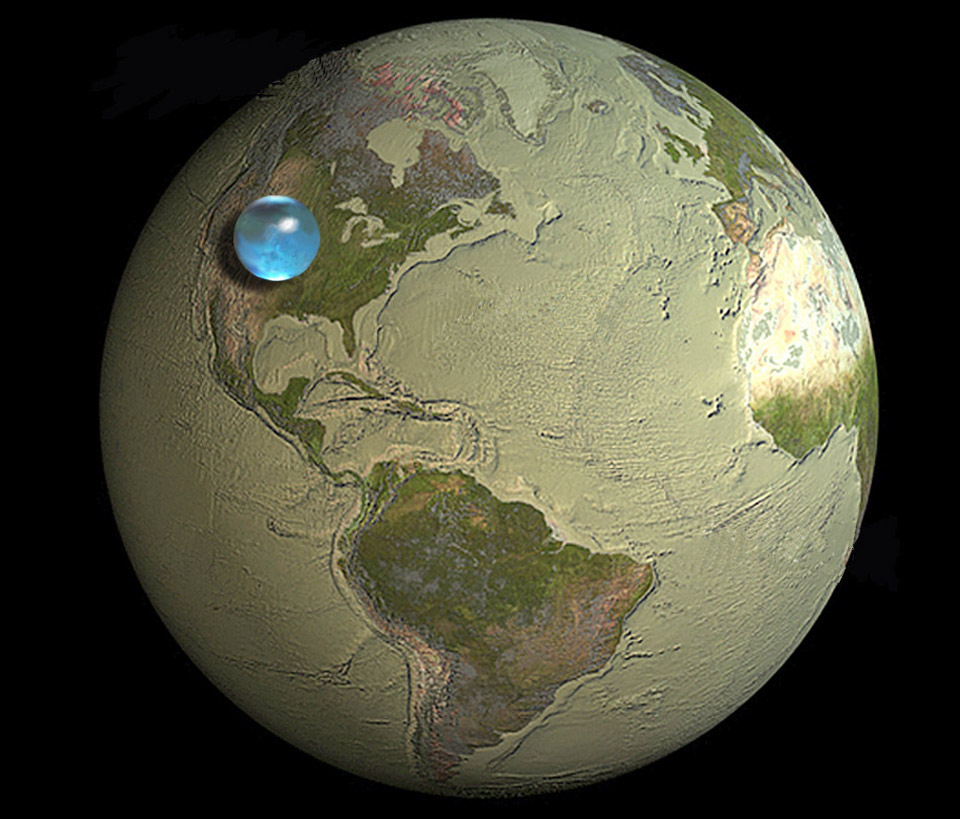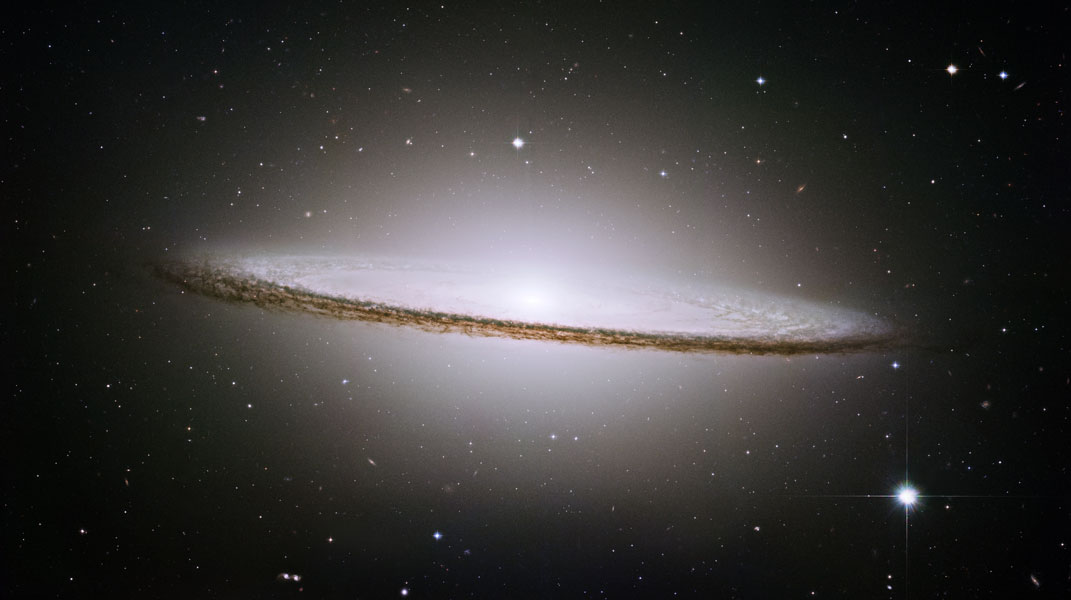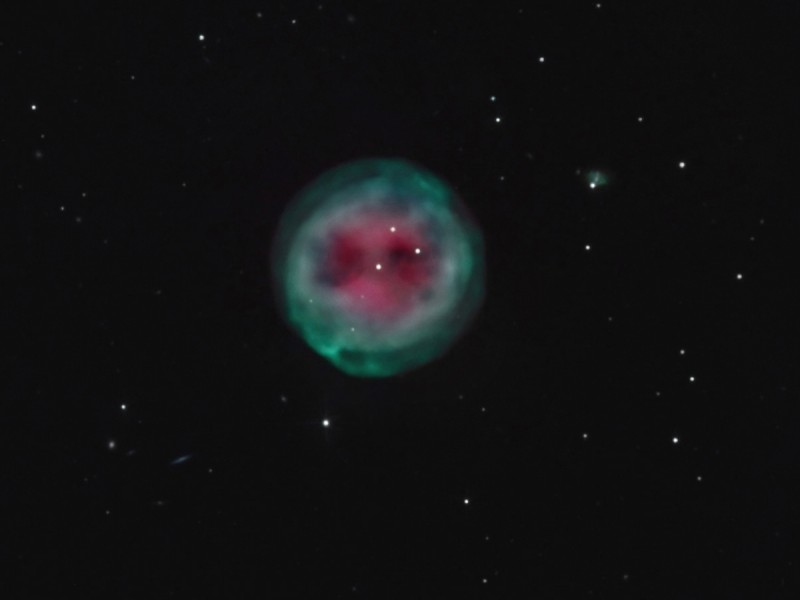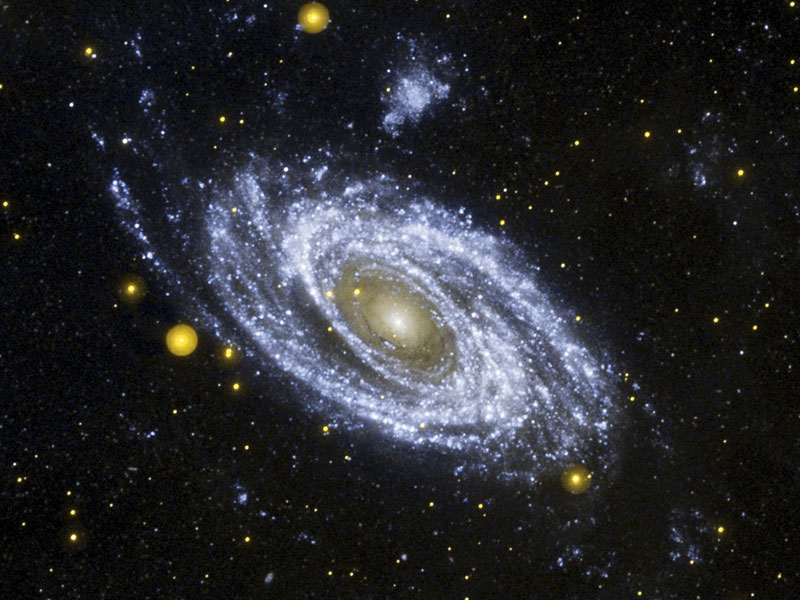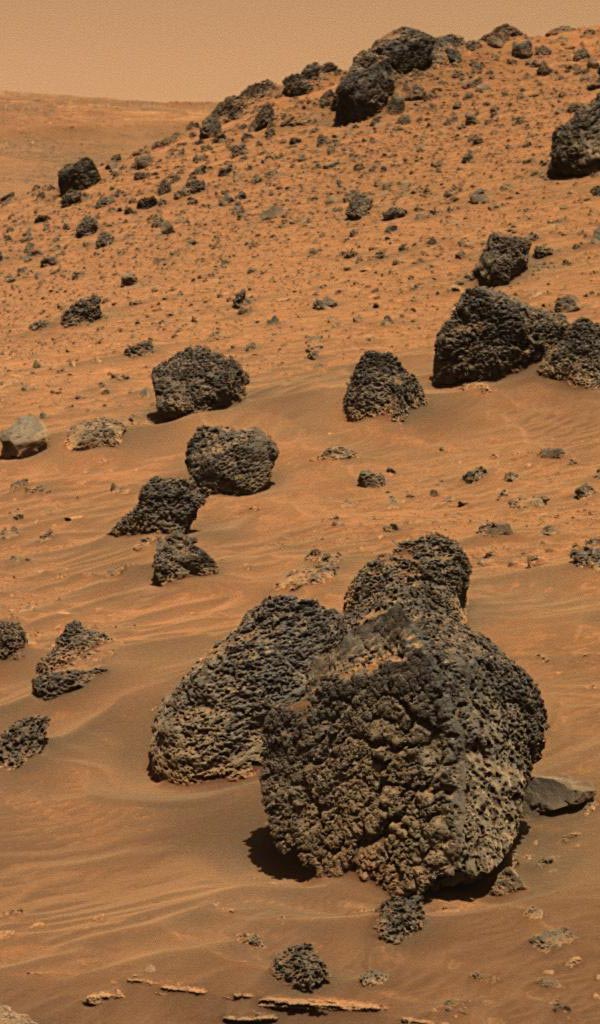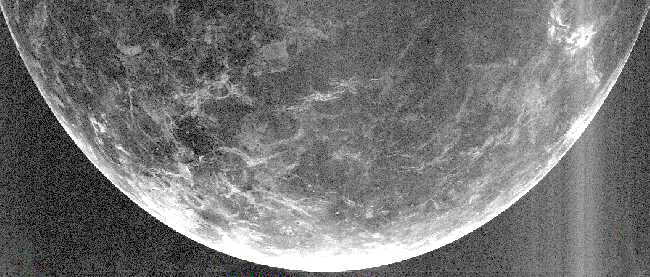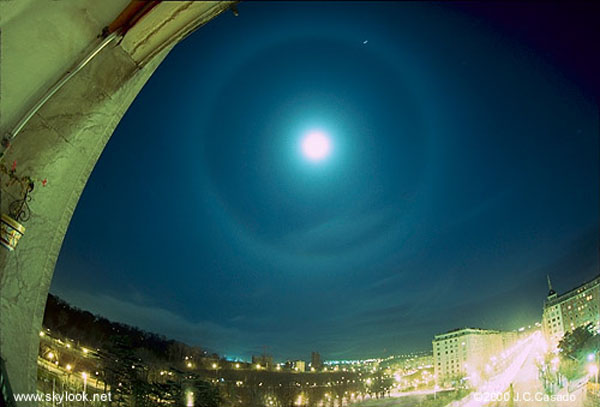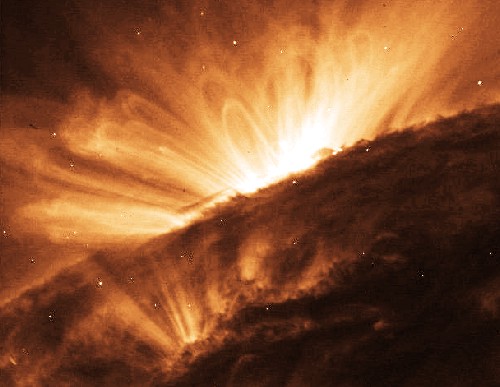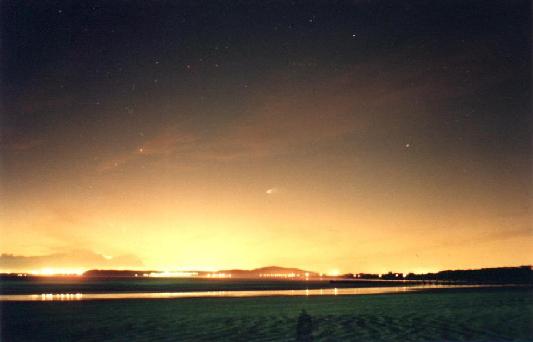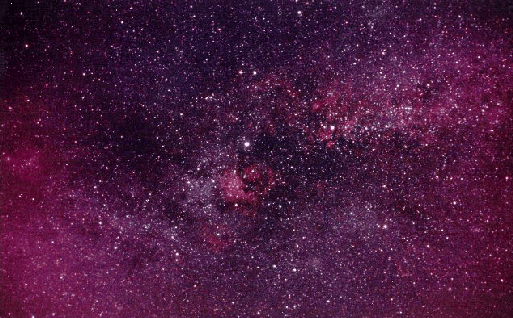| << Previous | Index | Next >> |
2015 In this sharp snapshot, the Solar System's largest moon Ganymede poses next to Jupiter, the largest planet. Captured on March 10 with a small telescope from our fair planet Earth, the scene also includes Jupiter's Great Red Spot, the Solar System's largest storm. In fact, Ganymede is about 5,260 kilometers in diameter. That beats out all three of its other fellow Galilean satellites, along with Saturn's Moon Titan at 5,150 kilometers and Earth's own Moon at 3,480 kilometers. Though its been shrinking lately, the Great Red Spot's diameter is still around 16,500 kilometers. Jupiter, the Solar System's ruling gas giant, is about 143,000 kilometers in diameter at its equator. That's nearly 10 percent the diameter of the Sun.
2014
2013 What caused this mess? Some type of star exploded to create the unusually shaped nebula known as Kepler's supernova remnant, but which type? Light from the stellar explosion that created this energized cosmic cloud was first seen on planet Earth in October 1604, a mere four hundred years ago. The supernova produced a bright new star in early 17th century skies within the constellation Ophiuchus. It was studied by astronomer Johannes Kepler and his contemporaries, without the benefit of a telescope, as they searched for an explanation of the heavenly apparition. Armed with a modern understanding of stellar evolution, early 21st century astronomers continue to explore the expanding debris cloud, but can now use orbiting space telescopes to survey Kepler's supernova remnant (SNR) across the spectrum. Recent X-ray data and images of Kepler's supernova remnant taken by the orbiting Chandra X-ray Observatory has shown relative elemental abundances typical of a Type Ia supernova, and further indicated that the progenitor was a white dwarf star that exploded when it accreted too much material from a companion Red Giant star and went over Chandrasekhar's limit. About 13,000 light years away, Kepler's supernova represents the most recent stellar explosion seen to occur within our Milky Way galaxy.
2012
2011 What's going on in the center of this spiral galaxy? Named the Sombrero Galaxy for its hat-like resemblance, M104 features a prominent dust lane and a bright halo of stars and globular clusters. Reasons for the Sombrero's hat-like appearance include an unusually large and extended central bulge of stars, and dark prominent dust lanes that appear in a disk that we see nearly edge-on. Billions of old stars cause the diffuse glow of the extended central bulge. Close inspection of the bulge in the above photograph shows many points of light that are actually globular clusters. M104's spectacular dust rings harbor many younger and brighter stars, and show intricate details astronomers don't yet fully understand. The very center of the Sombrero glows across the electromagnetic spectrum, and is thought to house a large black hole. Fifty million-year-old light from the Sombrero Galaxy can be seen with a small telescope towards the constellation of Virgo.
2010 Normally faint and elusive, the Jellyfish Nebula is caught in this alluring, false-color, telescopic view. Flanked by two bright stars, Mu and Eta Geminorum, at the foot of a celestial twin, the Jellyfish Nebula is the brighter arcing ridge of emission with dangling tentacles below and right of center. In fact, the cosmic jellyfish is seen to be part of bubble-shaped supernova remnant IC 443, the expanding debris cloud from a massive star that exploded. Light from the explosion first reached planet Earth over 30,000 years ago. Like its cousin in astrophysical waters the Crab Nebula supernova remnant, IC 443 is known to harbor a neutron star, the remnant of the collapsed stellar core. Emission nebula Sharpless 249 fills the field at the upper left. The Jellyfish Nebula is about 5,000 light-years away. At that distance, this image would be about 300 light-years across. The color scheme used in the narrowband composite was made popular in Hubble Space Telescope images, mapping emission from oxygen, hydrogen, and sulfur atoms to blue, green and red colors.
2009 The Owl Nebula is perched in the sky about 2,600 light-years away toward the bottom of the Big Dipper's bowl. Also cataloged as M97, the 97th object in Messier's well-known list, its round shape along with the placement of two large, dark "eyes" do suggest the face of a staring owl. One of the fainter objects in Messier's catalog, the Owl Nebula is a planetary nebula, the glowing gaseous envelope shed by a dying sun-like star as it runs out of nuclear fuel. In fact, the Owl Nebula offers an example of the fate of our Sun as it runs out of fuel in another 5 billion years. As we see it, the nebula spans over 2 light-years making it roughly 2,000 times the diameter of Neptune's orbit. Beautiful to look at, this color image shows impressive details within the cosmic owl. The composite includes images made through narrow-band filters for a total of 24 hours of exposure time.
2008 Dark dust lanes cut across the middle of this gorgeous island universe, a strong hint that NGC 3628 is a spiral galaxy seen sideways. About 35 million light-years away in the northern springtime constellation Leo, NGC 3628 also bears the distinction of being the only member of the well known Leo triplet of galaxies not in Charles Messier's famous catalog. Otherwise similar in size to our Milky Way Galaxy, the disk of NGC 3628 is clearly seen to fan out near the edges. A faint arm of material also extends to the left in this sharp and deep view of the region. The distorted shape and faint tidal tail suggest that NGC 3628 is interacting gravitationally with the other spiral galaxies in the Leo triplet, M66 and M65.
2007 Where are the hot stars in M81, one of the closest major spiral galaxies? To help find out, astronomers took a deep image in ultraviolet light of the sprawling spiral with the Earth-orbiting Galex telescope. Hot stars emit more ultraviolet than cool stars, and are frequently associated with young open clusters of stars and energetic star forming regions. Magnificent spiral galaxy M81, slightly smaller in size to our own Milky Way Galaxy, shows off its young stars in its winding spiral arms in the above image. Less than 100 million years old, the young stars are blue in the above false-color Galex image and seen to be well separated from the older yellowish stars of the galactic core. Visible above M81 is a satellite galaxy dubbed Holmberg IX. Studying the unexpectedly bright ultraviolet glow of this small irregular galaxy may help astronomers understand how the many satellites of our own Milky Way Galaxy developed. M81, visible through a small telescope, spans about 70,000 light years and lies about 12 million light years away toward the constellation of the Great Bear (Ursa Major).
2006 What created this unusually textured rock on Mars? Most probably: a volcano. Dubbed Bumpy Boulder, the strange stone measuring just under a half-meter high was found by the robotic Spirit rover currently rolling across Mars. Pits on the ragged rock are likely vesicles and arise from hot gas bubbling out of hot rock ejected by an active Martian volcano. Several similar rocks are visible near Bumpy Boulder that likely have a similar past. The above true-color image was taken about one month ago. The Spirit rover, now in its third year of operation on Mars, is weathering the low sunlight winter of Mar's northern hemisphere on a hillside slope in order to maximize the amount of absorbable battery-refreshing sunlight.
2005 Where did the gold in your jewelry originate? No one is completely sure. The relative average abundance in our Solar System appears higher than can be made in the early universe, in stars, and even in typical supernova explosions. Some astronomers now suggest that neutron-rich heavy elements such as gold might be most easily made in rare neutron-rich explosions such as the collision of neutron stars. Pictured above is a computer-animated frame depicting two neutron stars spiraling in toward each other, just before they collide. Since neutron star collisions are also suggested as the origin of short duration gamma-ray bursts, it is possible that you already own a souvenir from one of the most powerful explosions in the universe.
2004 In this stunning vista recorded with the Hubble Space Telescope's Advanced Camera for Surveys, distant galaxies form a dramatic backdrop for disrupted spiral galaxy Arp 188, the Tadpole Galaxy. The cosmic tadpole is a mere 420 million light-years distant toward the northern constellation Draco. Its eye-catching tail is about 280 thousand light-years long and features massive, bright blue star clusters. One story goes that a more compact intruder galaxy crossed in front of Arp 188 - from left to right in this view - and was slung around behind the Tadpole by their gravitational attraction. During the close encounter, tidal forces drew out the spiral galaxy's stars, gas, and dust forming the spectacular tail. The intruder galaxy itself, estimated to lie about 300 thousand light-years behind the Tadpole, can be seen through foreground spiral arms at the upper left. Following its terrestrial namesake, the Tadpole Galaxy will likely lose its tail as it grows older, the tail's star clusters forming smaller satellites of the large spiral galaxy.
2003 No special filters - or even a telescope - are required to enjoy a leisurely lunar eclipse. In fact, watched from all over the night side of planet Earth, these regular celestial performances have entertained many casual skygazers. Still, this eye-catching picture of a lunar eclipse may look unfamiliar. To make it, astrophotographer Doug Murray set his camera on a tripod and locked the shutter open during the total lunar eclipse of January 2000. The resulting image records the trail of the Moon sliding through the night, steadily progressing toward the total eclipse phase as seen from Florida, USA. Haunting red hues of diminished moonlight, common during the total phase of a lunar eclipse, are evident at the far right, along the slimmer portion of the trail. At least part of tonight's lunar eclipse will be visible in clear night skies over the Americas, Europe, and Africa. The eclipse should last over three hours from start to finish, with about 53 minutes of totality.
2002 As Comet Ikeya-Zhang approached the Sun two months ago, it developed a complex blue ion tail. The tail was composed of ions that boiled off the nucleus and were pushed away from the Sun by the out-flowing fast-moving particles of the solar wind. Complexity in the tail is created by comet nucleus rotation, variability in the comet surface evaporation rate, and variability of the Sun's magnetic field and solar wind. The above animation documents how Comet Ikeya-Zhang's tail changed over 30 minutes in ten consecutive 3-minute exposures on March 11. Comet Ikeya Zhang is now fading as it heads back to the outer Solar System. It should remain visible through a small telescope for another month.
2001 The largest radio telescopes in the world are working together to create a new map of the surface of Venus. The surface of Venus is unusually hidden by a thick atmosphere of mostly carbon dioxide gas. These thick clouds are transparent, however, to radar signals sent and received from Earth. The two radio telescopes generating the most powerful radar ever are the Arecibo Telescope in Puerto Rico and the new Robert C. Byrd Green Bank Telescope in West Virginia. The new survey will resolve details as fine a one-kilometer across, and will be inspected for changes since the last major radar map was made by NASA's Magellan spacecraft that orbited Venus from 1990 to 1994. Pictured above is part of a preliminary image showing details as small as five-kilometers across.
2000 Have you ever seen a halo around the Moon? This fairly common sight occurs when high thin clouds containing millions of tiny ice crystals cover much of the sky. Each ice crystal acts like a miniature lens. Because most of the crystals have a similar elongated hexagonal shape, light entering one crystal face and exiting through the opposing face refracts 22 degrees, which corresponds to the radius of the Moon Halo. A similar Sun Halo may be visible during the day. The town in the foreground of the above picture is San Sebastian, Spain. The distant planet Jupiter appears by chance on the halo's upper right. Exactly how ice-crystals form in clouds remains under investigation.
1999 Long ago in a galaxy far, far away, locked in their final desperate struggle against the force of gravity ... two stars exploded! stellar explosions - Supernovae - are among the most powerful events in the Universe, estimated to release an equivalent energy of up to 1 million trillion trillion (1 followed by 30 zeros) megatons of TNT. After the explosion, an expanding supernova envelope is observed to brighten over a a period of days to a maximum light output which rivals that of an entire galaxy before fading from view over the following months. Triggered by the collapsing core of a massive star or the nuclear demise of a white dwarf supernovae occur in average spiral galaxies only about once every 25-100 years. But a recent observation of NGC 664, a spiral galaxy about 300 million light years distant, captured a rare and colorful performance - two supernovae from the same galaxy. In this monitoring exposure the two supernovae, one reddish yellow and one blue, form a close pair just below the image center (to the right of the galaxy nucleus). The color difference is due to temperature - blue is hotter.
1998 This dramatic high resolution picture looking across the edge of the Sun was taken April 24th by a telescope on board the newly launched Transition Region and Coronal Explorer (TRACE) satellite. It shows graceful arcs of intensely hot gas suspended in powerful looping magnetic fields which soar above a solar active region. The colorized image was made in the extreme ultraviolet light radiated by highly ionized Iron atoms. With a temperature of a mere 6,000 degrees Celsius, the sun's surface is relatively cool and dark at these wavelengths, but the million degree hot plasma loops glow strongly! Such TRACE images follow the plasma and magnetic structures arising from the surface of the sun as they merge with the tenuous, hot solar Corona or outer atmosphere. By operating the TRACE instruments during the Sun's increasingly active phase, scientists hope to explore the connections between complex solar magnetic fields and potentially hazardous solar eruptions.
1997 Fighting the glow of the setting sun and the city lights of Cape Town, South Africa, comet Hale-Bopp is just visible near the center of this panoramic view - photographed on May 3rd. In the foreground is the Strand beach front, about 50 km East of Cape Town, while the Cape Peninsula mountain ranges can be seen at the left along the horizon. The bright star visible above and to the left of the comet is the red giant Aldebaran in the constellation Taurus. As Hale-Bopp continues its outbound journey during the month of May it will climb higher into evening southern skies. Still a bright comet it is now providing an enjoyable and much anticipated showing for Southern Hemisphere observers.
1996 This beautiful image of the sky near the bright star Deneb (just above center) reveals the stars, nebulae, and dark clouds along the plane of our Milky Way Galaxy as seen from the northern hemisphere (near Columbia Missouri, USA). Just below Deneb lies the suggestively shaped North America emission nebula. Deneb is the brightest star in the constellation Cygnus, located in the tail of this celestial swan. Cygnus contains the asterism known as the Northern Cross and marks one side of the "Great Rift" in the Milky Way, a series of dark obscuring dust clouds which stretches on through the constellation Sagittarius. Deneb defines the top of the Northern Cross while the body of the cross extends past the upper right corner of the picture. Cygnus also harbors the most famous candidate for a black hole in our galaxy, Cygnus X-1.
| << Previous | Index | Next >> |



